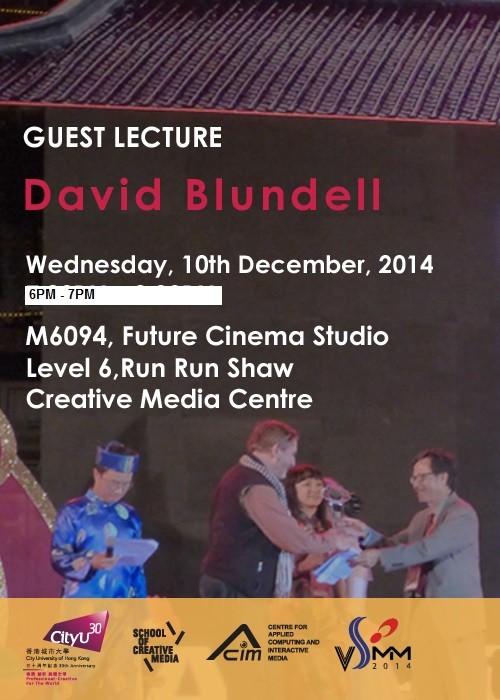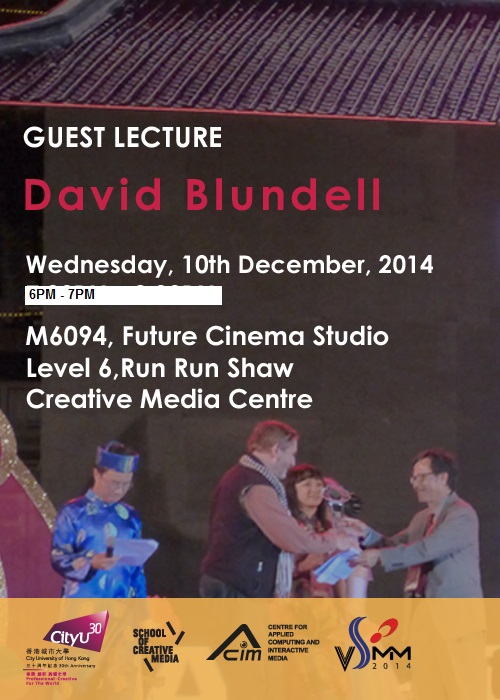Guest Lecture By Professor David Blundell
Seminar
10 Dec 2014
06:00pm - 07:00pm
M6094, Future Cinema Studio, L6, Run Run Shaw Creative Media Centre
|

|
Location :
M6094, Future Cinema Studio, L6, Run Run Shaw Creative Media Centre
Time :
6pm - 7pm
Date :
10.12.2014 (Wed)
Conducted in English
Free Admission
This Lecture is in conjunction with the 20th International Conference on Virtual Systems and Multimedia (VSMM 2014)
GUEST LECTURE SERIES
Title: Making Life History Buddhist Film
Speaker: Professor David Blundell
Professor of Asia-Pacific Studies, National Chengchi University, Taipei
Abstract
Anthropologists study to understand cultural systems. This field of study contributes to a holistic view of culture as an educational process. Clifford Geertz introduced ‘art as a cultural system’ as a way to illustrate a guiding factor in defining ethnicity and collective human identity.
Yet, aesthetics works on a theoretical plane that is multi-dimensional for the understanding of cultural expressions in society evincing its self-worth, worldview, and human organization. Therefore, the study of aesthetics as applied to anthropology (the study of humans in terms of language, biology, prehistory/history, and culture) is a look at a system that permeates life in depth.
This is a revisit to my film productions (1.) in Sri Lanka for the visual documentation of the autobiography of a Sinhalese Buddhist headmonk; (2.) a joint project with Canadian filmmaker, Ms Anika Tokarchuk, for her final edit production of a Life as Cinema about the making of Phörpa(The Cup): an independent feature film by Dzongsar Khyentse Norbu Rinpoche and other Tibetan monks who are rekindling their Buddhist faith in India and in some cases returning to Tibet to film documentaries on their heritage; and (3.) in India with the “untouchable” people (dalit) to work on a biographical film on Dr B R Ambedkar who rekindled Buddhism to kick start a social transformation movement for human rights.
The objective of this presentation is to give orientation to the understanding of making life history Buddhist film in past and present contexts. I will look at filmmaking in the process of ethics and local support in visual anthropology as a production by, for, and with the people it’s intended to represent. My intention is to show how I have dealt with questions in making visual biographical accounts in specific research contexts using shared techniques for comprehending the individual in the matrix of society. The ethnographic films I have done to share are made in South Asia, related to Buddhism, philosophy, aesthetic systems, and life’s experience utilizing the cultural tools at hand for achieving social goals. The results are life imprints in new media.
Biography of speaker
David Blundell received a doctorate in anthropology from the University of California, Los Angeles. His education was also derived from other institutions of leaning in the USA, Thailand, Sri Lanka, and Taiwan. Professor Blundell is currently employed at National Chengchi University, Taipei. His courses feature the anthropology of religions, ethnographic film and visual anthropology, life history accounts, language and culture, symbolic anthropology, Taiwan and Asia-Pacific as cultural areas, and aesthetic anthropology. Studies focus on social transformations in Southern Asia, folk traditions and development, indigenous and historical studies in Taiwan and across Monsoon Asia.
Dr Blundell is serving as Anthropology and Language Editor for the Electronic Cultural Atlas Initiative (ECAI) Austronesia Team, UC Berkeley, to supervise interdisciplinary GIS projects working with diverse groups on spatial temporal digital mapping. This is as an international consortium developing an educational database of Pacific languages and cultures from prehistory to the present serving as a bulletin board for scholarly exchange.
His films are projects in the arena of observing ethics from beginning to end in the research process for the people involved. It’s an intended product by, for, and with the people it represents. Filming procedures have followed in this way to take into account local aesthetic values to make a visual heritage document intelligible to the viewers of a specific culture. Some examples of films:
The Life History of Ven Hanchapola Gnanavansa Thero: A Buddhist Headmonk in Sri Lanka (1902-1979). Film. Color. 52 min. This project depicts the life and routine of a Buddhist monk who was ordained in 1919 and became a guiding force in his nikaya. Prior to the project, he no experience in film making, yet he organized the script, planned the scenes, and directed the story. Published by Dharma Heritage Foundation. http://www.dharmaheritage.org
